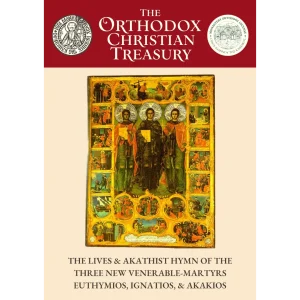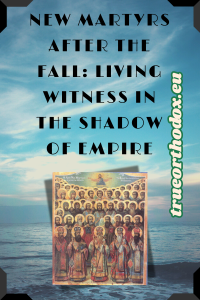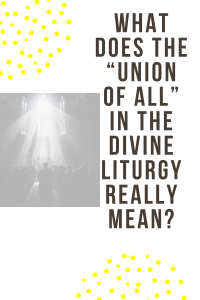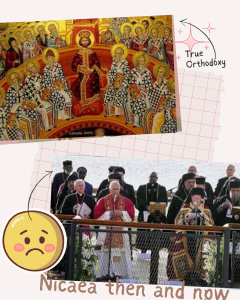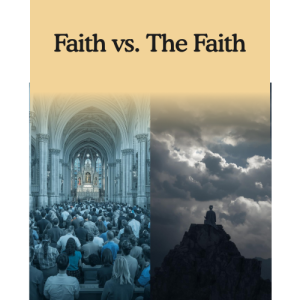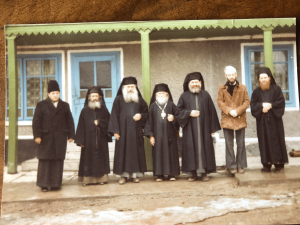THE GLORIFICATION OF THE NEW MARTYRS OF RUSSIA IS OUR SACRED MORAL DUTY by Archbishop Anthony of Los Angeles
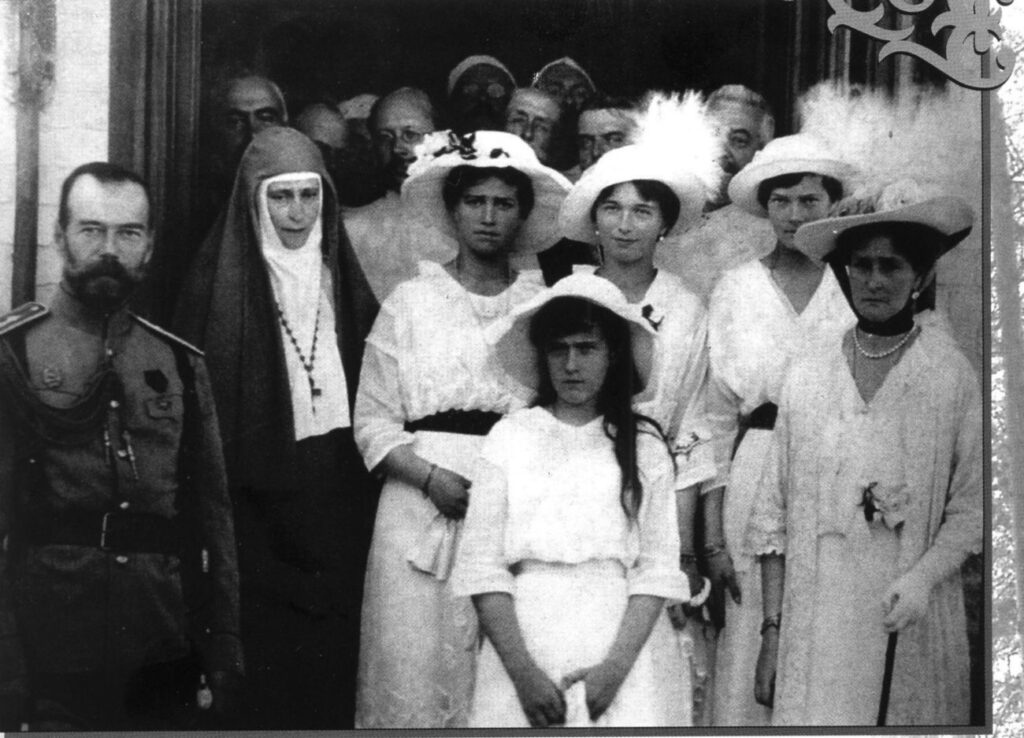
The issue of the glorification of the new martyrs of Russia, headed by the Tsar-Martyr and his martyred Royal Family, was raised at the Council of Bishops in 1971. The Council reacted favorably to this suggestion and in its resolution stressed that “the Council of Bishops bows with reverence before the sacred podvig of the new martyrs of Russia and is favorably inclined towards their glorification.” This issue was again raised at the Third Pan-Diaspora Council. By a decision of the Conference of Bishops of September 5/18, 1974, deliberation on this matter was delegated to the subsequent Council of Bishops, which in its resolution of September 18/October 1 spoke out in favor of glorification.
At the conclusion of this resolution it was decreed to do what is done during the final preparatory period prior to the glorification of saints, i.e., to add at the dismissal of panikhidas the words: “and by their holy prayers have mercy on us, for He is good and the Lover of mankind.”
At the same time that it became apparent that many hierarchs, clergy and lay people desire this glorification, objections were also voiced. These objections do not concern the essence of the matter. No one has attempted to refute the Church’s teaching that those who have suffered for the faith become holy martyrs by virtue of their sufferings alone.
The objections touch principally upon four points:
1) that this is not now the time to glorify the martyrs;
2) that the glorification of the Tsar-Martyr and his family would be a political act;
3) that the glorification would provoke divisions within the flock in the diaspora; and
4) that the glorification can be performed only in Russia, on a pan-Russian scale.
We will reply to each of these objections.
1. “THIS IS NOT THE TIME TO GLORIFY THE MARTYRS.”
We must agree completely with the essence of the opinion that this is not now the time to glorify the new martyrs, because the correct time for their glorification was July 4/17, 1918 for the Royal Family, and on the respective dates of their murders for all the other new martyrs. We are already fifty-six years late, If the martyrs are not glorified now because it would be too “early,” then, when our generation, those who witnessed the Revolution, who are now already two-thirds gone, has finally departed, and the new generation, having departed from everything Orthodox and Russian, and a majority of whom almost never come to church, completely supplants us, it will indeed be too late. Let us not even mention the possible political upheavals, which not without reason the whole world fears, and which could prevent the glorification despite a general desire for it. It came to light at the Third Pan-Diaspora Council that only about ten percent, and at best as many as twenty-five percent of our children do not break their ties with the Orthodox faith and Church.
From the time of the apostles and the martyrdom of the holy Protomartyr and Archdeacon Stephen, the Holy Church has glorified its martyrs from the time of their martyrdom, demanding neither preliminary sanctity of life, nor veneration of their lives by the faithful, nor miracles; the spilling of blood for the faith in and of itself elevates those who suffer it to the rank of the holy martyrs, This was first done upon the slaying of the holy Protomartyr and Archdeacon Stephen, who was glorified immediately, a church being built in his honor by the holy Apostles Jason and Sosipater (commemorated April 28); the Greek Church treats martyrs in this way even to the present day; i.e., all those who have suffered for the faith are immediately revered as holy martyrs, even without any canonical inquiry by the Church (Prof. E. Golubinsky, On the Canonization of Saints in the Russian Church, pp. 26-27). One ought to keep in mind that, in portraying the sufferings of the holy martyrs, the ancient narrators did not intend to set forth how their glorification took place, depicting only the martyrdom itself. Thus, in a great many instances, nothing at all is said about the glorification; in other cases, this is mentioned only briefly. Nonetheless, there is a mass of documentary evidence concerning the immediate glorification of martyrs; more exactly, St. Dimitry of Rostov cites about 1,400 of such passionbearers. And so, beginning with the Menology for January, let us consider which saints were glorified immediately. Such were:
The holy martyrs Julian and Basilissa in 313; the holy martyrs Theophilus and Helladius early in the fourth century; the holy martyr Agnes in 304; the holy martyr Anastasius the Persian in 528; the holy martyr Agatho in 312; the holy martyrs Boris and Gleb—who were glorified and for whom a church was built by their boyar Ephrem, later known as St. Ephrem of Novotorzhk—in 1015, the year of their slaying.
In the February volume we find mentioned: the holy martyr Tryphon (c. 240); the holy martyr Theodore the General in 319; the twelve holy martyrs Pamphilus, Valens, Paul, Seleucius, Porphyrius, Julian, Theodulus, Elias, Jeremiah, Isaiah, Samuel, and Daniel in 309; the holy Greatmartyr Theodore the Recruit in 306; the holy martyrs Maurice and Photinus, and with them 70 soldiers (c. 306); the holy hieromartyr Polycarp of Smyrna, during the reign of Marcus Aurelius (i.e. between 161 and 180); the holy martyrs Fausta, Evilasius, and Maximus in the early fourth century (Maximus being a torturer who was converted to the faith upon seeing the sufferings of the virgin Fausta and at once received a martyrs death; that is, he had been a persecutor and murderer right up to the time of his martyrdom); the holy hieromartyr Charalampus in 202; the holy hieromartyr Blaise in 316; and the holy prince Michael of Chernigov and his boyar Theodore in 1245.
In the March volume we find mentioned: the holy martyr Conon in the first century, a church being immediately built in his honor; the forty Martyrs of Sebaste in 320; the holy martyrs Chrysanthus and Daria in 283; the twenty-six martyred Goths, and with them the martyr Alla (c. 380); and the holy hieromartyr Hypatius, killed by an Arian woman in 326.
In the April volume we find mentioned: the holy martyr Eupsychios in 262, in whose honor a church was immediately built; the holy martyr Thomais, who did not formally suffer for the faith, but for her chastity, and was immediately glorified by a simple monk, known later as St. Daniel (in the fourth or fifth centuries); the holy martyrs Processus and Martinian (c. 69); the holy hieromartyr Antipas (c. 85); the holy martyrs Anthony, John, and Eustathius of Lithuania, in 1346 or 1347; the holy martyr Sabbas in 327; the holy bishop Januarius, and with him the deacons Festus, Proclus, and Sosius, the reader Desiderius, and the laymen Eutychius and Acutius in 305; the nine martyrs of Cyzicus (late third century), in whose honor a church was built immediately.
This list, spanning only four months, names two hundred holy martyrs whose immediate glorification is testified to by their lives and who were entered in the Menology, the day of their commemoration being recorded. To avoid making this list too lengthy, we will limit ourselves to saying that the lives of the saints in the remaining eight books, from May through December, show about 1,200 more martyrs who were glorified immediately, of whom we should take notice of the extraordinary and zealous veneration of the first Christians for the Holy Forerunner and Baptist John, who was martyred by Herod, and for his holy relics, which veneration is attested to by the Life of the Holy Apostle and Evangelist Luke (October 18).
Under the Roman Empire, with its highly developed system of Roman law and legal procedure, which to this day has not lost its importance, everything pertaining to the torture of the Christians was recorded in protocols, the so-called “Acts of the Martyrs,” which are the historical documents from which St, Dimitry of Rostov drew most of his information on the martyrs.
In the life of the holy hieromartyr Anthimus, Bishop of Nicomedia (commemorated September 3), it is related how Emperor Diocletian ordered that the bodies of the holy martyrs be dug up and cast into the sea, thereby attempting to prevent the Christians from venerating the remains, i.e., the relics of the holy martyrs. This further affirms the Church’s veneration for all those who are martyred for the holy faith, and of their holy relics.
The hesitation of some people on the issue of the glorification of the new martyrs may be explained, among other reasons, by the fact that many centuries separate the Russian Church from the age of the first martyrdoms, with the result that the teaching of the Church on the glorification of martyrs has been lost by a great many of the Russian faithful; we have lost touch with it. In other words, this hesitation may be explained by ignorance, as a result of which they require of the martyrs that which is not demanded of them, but which is necessary for the glorification of other saints, namely, miracles, holiness of life, and general veneration. The easiest way for such people to be convinced is for them to acquaint themselves with the teaching and practice of the Church in regard to the glorification of martyrs.
Thus, we must be fully aware that the time to glorify holy martyrs for the faith is the moment of their slaying. Moreover, there is no difference between ancient and new martyrs; this has previously been demonstrated (cf. Archbishop Anthony’s report to the Synod of Bishops concerning the martyrs). In addition, itis important to become aware of the opinion of St. John Chrysostom on the glorification of new martyrs. In his panegyric on the holy new martyrs Juventinus and Maximus, who suffered under Julian the Apostate (c. 362), not long before he delivered this eulogy, St. John Chrysostom says: “These martyrs were slain not long ago . . . You do not honor the ancient martyrs in one way, and the new martyrs in another, but you honor and accept all of them with the same Zeal, the same love, the same fervor. Inquire not about the time, but seek courage, piety of the soul, unshakable faith, inspiring and ardent zeal of the type shown by those who have drawn us together today” (Works, Vol. Il, p. 618).
From these words it is apparent that both St. John Chrysostom and the faithful lay people in equal measure zealously honored the new martyrs of their times as saints. Chrysostom commended them for this veneration. Everyone together, both hierarchs and simple believers, glorified and honored the new martyrs of those days in the same manner as the ancient martyrs.
2. “THE GLORIFICATION OF THE TSAR-MARTYR AND HIS FAMILY WOULD BE A POLITICAL ACT.”
Another objection to the glorification is that it would be called a political act, especially as regards the Tsar-Martyr and his family.
We will speak to the point, in a way that befits an honest, believing Christian. The Tsar-Martyr, and his family as well, suffered for Christian piety. He was opposed to the amorality and godlessness of the communists, both on principle and by virtue of his position—on principle, because he was a deeply believing Orthodox Christian: by virtue of his position, because he was a Staunch Orthodox Monarch. For this he was killed. To ask him anything concerning the faith was unnecessary, because he gave witness before the tormentors to his steadfastness in Christian principles by his entire previous life and works, and especially by his profoundly Christian endurance of the moral torments of his imprisonment. He was a staunch defender and protector of the Christian faith, preventing the God-haters from beginning a vicious Persecution against believers in Christ and against the whole Orthodox Church. For this reason he was removed and slain.
Here it would be appropriate to cite the Church’s teaching that St. John the Forerunner was a martyr for Christ. In the service for his Beheading (Aug. 29), we find the following sticheron: “What shall we call thee, O Prophet: angel, apostle, or martyr? Angel, for thou hast lived as one without flesh; apostle, for thou didst teach the nations; or martyr, for thy head was cut off for Christ” (First stikhiron at the Litia; further on in the service, St. John the Forerunner is several times referred to as a martyr). It is known from the Gospel that Herod ordered John’s head cut off in prison because he had chastised Herod for his illicit relationship with Herodias. No one asked him about his faith; no one ordered him to renounce his faith. They slew him without speaking to him at all. Why then does the Church teach that he was a martyr for Christ? Because the Holy Church always looks at matters in their essence, not formally. St. John the Forerunner, being a devout follower of the Savior, opposed Herod’s adultery on principle, because he loved the teaching and commandments of the Lord Jesus Christ. It would have been completely useless and hopeless to attempt to persuade him to renounce his views. Herod understood this. Therefore, he killed him. This was not a political killing for opposition to Herod as the representative of civil authority, but a martyrdom for his faithfulness to Christ.
Completely analogous in its purpose and character was the slaying of the Tsar-Martyr, who is thus also a martyr for Christ.
There are other examples of slayings which outwardly were not for the faith, but which in essence were indeed for Christ. Such was the death of the holy hieromartyr Hypatius of Gangra in 326, killed by an Arian woman who smashed his head with a rock without any preliminary arguments or discussions, simply because he was a staunchly Orthodox bishop. And the Church glorified him as a martyr for the faith in Christ. The holy martyr Thomais (fourth or fifth century) suffered not for the faith, but for chastity, but she had preserved her chastity because she believed profoundly in the Lord Jesus Christ, honoring His teaching and commandments, including the commandment on chastity. Therefore, the holy Church glorifies her as a martyr for Christ. The martyred Goth, the holy prince Hermenegild, was beheaded in 586 for his refusal to receive Arian communion, and the Church glorifies him as a martyr for Christ (commemorated November 1). The holy Church understands that he was a steadfast Orthodox Christian, and his steadfastness served as the cause of his slaying and subsequent glorification. His royal lineage did not prevent his glorification. No one objected to his glorification on the grounds that it would be a “political act.”
It is also known from witnesses still alive that prior to the Revolution it was proposed that the Tsar repeal the strictures against anti-Christian secret societies, and it was threatened that if he refused he would lose his throne and his life. The sovereign firmly refused this proposal. Therefore, they deprived him of his throne and killed him. Thus, he suffered precisely for the faith. Itis a secret to no one that the chief purpose of the communist regime is to oppose the Christian faith. Everyone knows the motto of the communists: “Religion is the opium of the people.” The Catacomb Church speaks of this in one of the recent issues of Samizdat, “The Essence of Soviet Authority — Struggle against God” (Vol’noe Slovo, 1972). A Christian Tsar was hateful and intolerable to this authority. For this reason, they slew him and his Christian family.
The notion that engaging in politics is reprehensible has been advanced in an entirely erroneous fashion by the enemies of the faith. This has been done that only those who are against the Church may engage in politics, with great benefit for themselves and with great harm to the faith. In reality, politics, according to the meaning of this word (in Greek, “civil, municipal, pertaining to citizens”), are principally public affairs in which governments engage. The Lord Jesus Christ, however, came to earth to save people; i.e., He engaged in public activity, or politics. He commanded the apostles to “. . .teach all nations, baptizing them in the name of the Father, and of the Son, and of the Holy Spirit: Teaching them to observe all things whatsoever I have commanded you. . .” (Mt. 28:19-20). Thus, the apostles, too, engaged in politics. The Church has a purpose for working within human society and influencing all of its parts, including governments, giving her approval to those that promulgate the Christian faith and chastising those that oppose it. This also is politics and, at the same time, the duty of the Church. An erroneous understanding of the word “politics” is well illustrated by a satire from Soviet life: “There were three workers on a bench… One sat there and sighed. Another looked at him and also sighed. The third said uneasily: ‘Comrades, again you have touched on politics!’ ” Thus we can readily note how the Soviet regime labels as politics that which is not really politics. Are we really going to go the way of the Soviet regime, by unnaturally distorting the meaning of the word “politics,” and considering the word itself to signify some particular sort of crime?
In 1927, Metropolitan Sergius ordered all bishops in the diaspora to signa statement of loyalty to the Soviet regime. Such a statement was signed by Metropolitan Evlogy, who did not confine himself to signing the statement, but immediately began loudly to accuse the bishops in the emigration of “politicking.” If we are so afraid of this word and accusations of politics, it would have been logical and consistent to repudiate such “politics” and sign a statement of loyalty to the Soviet regime. But everyone understood that it was impossible to obey the sly voice of Metropolitan Evlogy, and the bishops of the diaspora did not heed it. Why then are we now suddenly so afraid of this word “politics,” since the glorification of holy martyrs, regardless of their social standing, is not politics, but the teaching of the Holy Church?
If we are to be afraid of the word “politics” and consider the idea of it to be reprehensible, then we have all made an error in fleeing from the communists and forming a “political” emigration. To be consistent, we should correct this error and return to Soviet Russia.
If, bearing in mind all that we have said, we exclude the Tsar-Martyr and his family from the ranks of the martyrs for so-called “political” reasons, we would be violating impartiality, ignoring the teaching of the Church on the holy martyrs, acting unfairly, as the contemporary expression goes, “discriminating” against the Royal Martyrs; and we would be guilty of political activity in the worst connotation of that word, which the enemies of the faith try to attach to it, employing a bias which is pleasing to the enemies of Christ and to the revolutionaries. Thus, the opinion that the glorification of the Royal Martyrs is a political act can exist only as a result of misunderstanding and does not stand up to the simplest criticism.
3. “THE GLORIFICATION OF THE NEW MARTYRS OF RUSSIA WILL PROVOKE DIVISIONS IN THE FLOCK IN DIASPORA.”
in noble undertakings, one is not guided by the opinion of the majority; nor does one take into consideration the opinion of the enemies of the Church. Otherwise, we would have to acknowledge the crucifixion of the Lord Jesus Christ to have been proper, because it was the result of the demand of the majority! Matters of principle in the faith and Church teaching cannot be put to a vote —both the faith and the teaching of the Church must be closely guarded.
The glorification of the slain Royal Family and the great assembly of holy martyrs is a requirement of Church teaching, not only because martyrs become saints through their sufferings, but also saints equal to the angels. St. John Chrysostom says: “After leaving this world martyrs ascend to Heaven; the angels precede them and archangels accompany them. After their ascent to Heaven, all the holy powers meet them, greet them joyfully, and with great solemnity lead them to the King of Heaven, to the throne surrounded by the cherubim and seraphim, where they are enrolled in the choirs of angels” (“Panegyric for All the Holy Martyrs,” Works, Vol. Il, p. 757).
This statement coincides with the teaching of the Church, which in the following words depicts the status of the holy martyrs as equals to the angels: “Blessed is the army of the King of Heaven; for if they that were born on earth have been passionbearers, yet did they strive to attain the angelic rank; and caring not for the things of the body, they were vouchsafed the honor of the bodiless hosts. Wherefore, by their supplications, O Lord, send down upon us great mercy” (Octoechos, Tone V, from the Aposticha for Monday Matins).
It is not a coincidence that in some church hymns, the martyrs are placed directly after the apostles, above the prophets, holy hierarchs and all the other saints: “O ye apostles, martyrs and prophets, holy hierarchs, ye venerable and righteous, that did complete the course well and kept the faith, having boldness before the Savior: in that ye are good, entreat Him for us, we beseech you, that our souls be saved” (Troparion for Saturday).
This is the principle solemnly pronounced by God: “Thou shalt not follow a multitude to do evil; neither shalt thou speak in a cause to decline after many to wrest judgment” (Ex. 23:2). Our Church constantly reminds us, as the Third Pan-Diaspora Council has also reminded us, that we are not with the majority, but with the truth and with the saints. The example of St. Maximus the Confessor shines for all time. When almost all the people of Constantinople had joined the Monothelite heresy and, in order to draw into their heresy those who had followed the spiritual authority of St. Maximus, they tried to force him to take communion with the heretics, pointing out that even the emperor and the patriarch had done so, he replied: “Even if the whole world takes communion, I alone shall not.” St. Maximus the Confessor’s steadfastness, for which he endured great torments, could formally be called division. The Church, however, has not called it division, but a glorious confession of truth.
Here is another example which shows that we must maintain the truth without fearing to be left in the minority. In Constantinople, in the time of one of the three great universal teachers and hierarchs, St. Gregory the Theologian, the Orthodox faith was preserved only in the single, small, dilapidated Church of the Resurrection, abandoned by the heretics as useless, in which St. Gregory the Theologian served and preached. This was not division, but preservation and confession of the truth, for which the Holy Church glorifies St. Gregory. Nowadays the fallacious slogan “Unity for the sake of unity” is quite widespread. This slogan is an extremely unprincipled one. If one were to adhere to it, one would have to unite with all criminals and those who oppose God. The ancient universal Church did not look upon this question thus. The most heated arguments, often divisions, took place at the Ecumenical Councils, because the Orthodox did not consider it possible to ignore the truth for the sake of an outward semblance of peace. There were even instances of what could be called “scandals,” as, for example, when St. Nicholas struck Arius. The Lord Himself and His All-pure Mother, however, approved of this act, and to this day their approval is witnessed to by their portrayal in icons of St. Nicholas, blessing him for this action. St. Nicholas struck Arius, not under the influence of personal ill-will or anger, but in the hope of influencing the hardhearted heretic in a way which corresponded to his coarse soul, as when the Savior drove the buyers and sellers from the Temple. Many did not immediately understand this, but God Himself bore witness to the correctness of the actions of St. Nicholas, who put the defense of the faith above the superficial, tangible world.
Both the Sacred Scriptures and the Church teach of good division and of evil agreement. “Blessed is the man that hath not walked in the counsel of the ungodly” (Ps. 1:1), “as for the oil of the sinner, let it not anoint my head” (Ps. 140:5), “with the perverse wilt thou be perverse” (Ps. 17:27). These are examples of good division.
In the service for Pentecost, we read of evil agreement: “The power of the divine Spirit which hath come and which of old divided the common tongue of them that evilly assented in one accord [to the construction of the tower of Babel] hath divinely united [us], enlightening the faithful with the knowledge of the Trinity, wherein we are made steadfast” (Canon I, Ode III, Troparion 1).
Thus, before fearing “divisions,” we must be aware of the category into which we should place these divisions. If they are a violation of Christian peace, based on enmity, anger and hatred, they are reprehensible in the extreme. If they are an indication of the preservation of truth, then, on the contrary, such divisions should not be feared. The holy Apostle Paul says: “For there must be also heresies among you, that they which are approved may be made manifest among you” (I Cor. 11:19). We dare say that fears of “divisions” are premature, and that the threat of these divisions is, on the part of certain people, very close to demagoguery, i.e., the advocating of attractive ideas or slogans for quite different, hidden purposes. In the given instance, an attractive “concern” is shown for the peace of the Church, which no one has yet disturbed; this has as its hidden purpose the bringing to a halt or delaying of the holy work of glorifying the martyrs. Let us remember that the ancient teaching of the Church on the immediate glorification of martyrs not only never required general agreement, but glorification immediately after the repose of the martyrs was carried out both by the whole Church, and by individual bishops, and very often by individual laymen and laywomen.
4. “THE GLORIFICATION OF THE MARTYRS SHOULD BE POSTPONED INDEFINITELY, BECAUSE THEY CAN BE GLORIFIED FITTINGLY ONLY WITH THE PARTICIPATION OF THE RUSSIAN PEOPLE IN RUSSIA.”
A partial answer to this objection has already been given in our report to the Synod of Bishops on the glorification of the new martyrs. But some, even among those who supposedly have familiarized themselves thoroughly with this report, have not found an answer in it. Therefore, let us reiterate it in a clearer form.
From the history of the glorification of saints, we know that there are s0-called “local” and “general” glorifications. Local glorifications take place in those instances in which the glorification and prayers to the saint are limited to a particular place, for example, to a particular area, city or monastery. In the other parts of the Church, such a saint is not venerated. Usually, local saints become generally recognized with the passage of time.
In the history of the Russian Church, a vivid example of general glorification after a preliminary local one occurred in connection with the Stoglav Council of 1551. Metropolitan Makary of Moscow, having as his goal the spiritual renewal of the Russian Church at the Stoglav Council, felt that there would be no better way to effect such a renewal than to enlist the heavenly intercession of the holy saints. Thus, he compiled a list of all local saints then known, twenty-two in number, who had been glorified by the whole Russian Church at councils which had taken place immediately before the Stoglav Council, in order to have the ready help of the saints.
We are not now speaking of a pan-Russian glorification of the new martyrs, but of a local one, only within the limits of the Russian Church Abroad, as was indicated in the report to the Synod of Bishops. Such a local canonization in no way precludes the possibility of glorifying the new martyrs in Russia for general veneration, as was done by Metropolitan Makary before the Stoglav Council.
Who can say how much time we will have to wait before the possibility presents itself for the free glorification of saints in Russia? If the Church in Russia is now persecuted and deprived of freedom, must we, its free part, consequently halt Church life and the confession of the faith? Will we not have t0 answer to God for such unconscionable inaction?
There is yet one even more important reason which refutes the arguments of those who desire the glorification to be held in Russia. Those who believe that the glorification of the holy new martyrs should be performed in Russia because it must be fitting and solemn, and not paltry, apparently consider the principal feature of this event to be the physical act or rite of glorification. Our Church, however, in accordance with the precept of its Head, the Lord Jesus Christ (Mt. 6:33), has always and in everything sought and pursued, first and foremost, a spiritual goal, and gives only secondary importance to the external side. The glorification of saints is the possibility, proclaimed by the Church, of turning to the intercession of the saints, who have been glorified by God in Heaven, and to glorify them on earth as holy persons who are especially close to God, and who have received the grace to intercede for us. Therefore, the chief significance of glorification lies not in the actual rite itself, but in the benefit derived from the prayer and example of the saints, which we receive for all time to come, beginning with the day of glorification. The Church universal has regarded it thus from time immemorial. A solemn glorification did not exist at all in antiquity, and the Greek Church does not have one even at the present day (Prof. Golubinsky, The History of the Canonization of the Saints in the Russian Church, pp. 22, 23 and 31). The holy martyrs, like the other saints, began to be venerated as heavenly intercessors and protectors, and their names were written down in monthly listings. This constituted their glorification.
In the objections which state that the glorification must needs take place in Russia, regardless of the fact that it would be a radiant joy for the Church and a triumph of the faith, and regardless of clear historical precedents for double glorification, first local, and later general, one cannot help but see an attempt to put off the glorification by whatever means necessary. I have heard from many devout believers expressions of sad bewilderment in connection with the objections to the glorification. If the objections had come from enemies of the faith, they say, it would be understandable. But when those who call themselves believing Christians object, it would be logical for all of us who live in freedom to begin to do what would please the God-haters, not only on the issue of the glorification, but in other instances as well, as, for example. to cease all opposition to the atheists and others who attempt to destroy the Christian faith. This is how many of the most devoted and invaluable of the faithful feel; and, since we are analyzing objections to glorification, it is fair to hear out the other side by explaining its point of view.
St. John Chrysostom decisively and repeatedly maintains that the principal culprit and operating force behind the persecution, torture and death of the holy martyrs was the devil, who disposed and incited the tormentors to do such things. Our divine services bear witness to this (cf. the stichera to the martyrs for Friday evening of Tone I). But usually the malice of the devil is put to shame and serves for our salvation. “Such has the been the practice of God from of old, even from the very beginning: that which the devil devises against us, He turns back against his head and employs for our salvation. Note this: the devil drove man from paradise, but God opened Heaven to him: the devil deprived him of his earthly dominion, but God gave him the heavenly Kingdom and placed our nature upon the royal throne. Thus, He always gives us good things which are greater than those which the devil strives to take away. And He does this to prevail upon him to be slower in his machinations against us, and to teach us never to fear his wiles, as the martyrs have shown us” (St. John Chrysostom, Works, Vol. II, p. 655). The same thing happened in Russia, which has been taken captive by the devil. The devil has been deceived. True, he has lured into sin a multitude of those who were weak in heart and unsteady in their Christianity. But, at the same time, there has shone forth in the Russian land, as never before in history, a great multitude of martyrs for the faith, of whom it would be impossible to give an accurate enumeration; but in any case, employing even the most modest approximation, numbering in the millions over a half century; while in the whole previous history of the Church, including the first three centuries of persecution, the Church acquired a total of 350,000 holy martyrs, who are recorded in the Menologia.
Only now, after long persecution, does the beneficial purpose for which the merciful Lord has allowed terrible misfortunes to befall much-suffering Russia come to light—that through them will be shown the repulsiveness of evil, the power of faith, and the beauty of the Gospel. Newly-arrived believers from Russia have borne witness to this renewal, and to the general respect for Christianity, even within the Communist Party, and to the devout faith in God, and to spiritual thirst, and to the return to the faith of millions of the intelligentsia and the youth, and to the fact that Russia today is the most Christian country in the world, despite the continuing, cruel persecution (A. Levitin, Y. Handler, V. Maksimov). The words from St. Basil’s Third Kneeling Prayer for Vespers on Pentecost are beautifully appropriate as regards this unexpected miracle of the beginning of the spiritual resurrection of the Russian people: “…and having enticed, by divinely wise allurements, the origin of mischief and the serpent of the abyss…” (i.e., having conquered the malice, wiles and deceit of the hidden devil, the source of evil, by divine wisdom). Indeed, the devil did not imagine that his intent to destroy Christianity and to plant ungodliness would be the cause of a spiritual rebirth of the Russian people, who had seriously forgotten God.
5. “WHY MUST THE TSAR-MARTYR STAND AT THE HEAD OF THE NEW MARTYRS AND FROM WHENCE COME THE OBJECTIONS TO THIS?”
The physical destruction of the Tsar-Martyr removed the obstacle preventing the beginning of an unprecedented persecution aimed at the complete eradication of the faith. His martyrdom paved the way for a whole throng of new martyrs, who have glorified the Church by their blood. To begin the general persecution, it was not enough to deprive the Tsar-Martyr of freedom and power. The devil feared that if he were left among the living, many would be inspired with a desire to return him to the throne, to cease the devastation, famine, suffering and persecution. Therefore, he suggested to the God-haters the criminal decision to deprive him of life. In view of all these incontrovertible facts, the Tsar-Martyr stands at the head of all the new martyrs, just as in life, as God’s anointed, he headed and ideologically protected Orthodox Russia. It is not mere coincidence that the Holy Church proclaimed St. Constantine the Great and St. Vladimir, like him two heads of Orthodox kingdoms, as Equals-to-the-Apostles. Of the multitude of holy bishops contemporary to them, none (with the possible exception of St. Nicholas) was so highly placed in the order of the saints as they, even though they did not have that exceptional advantage and superiority which the pious Sovereign Nicholas Aleksandrovich had, for he became a martyr. The glorification of the Tsar-Martyr and the martyred royal family will especially perturb their murderers, those who followed them, and those of like mind with those who committed their crime in profound secrecy, because they feared being held responsible by the Russian people, and out of profound hatred for the Orthodox system of the Russian State. By God’s Providence, their dark crime was uncovered and they gave the Russian people a Tsar-Martyr. This had in no way entered into their calculations, for the main purpose of the Goa-haters is the destruction of the Orthodox Faith and Church, a fact which is to this day witnessed by the violent persecution of the faith and of the “True Orthodox” (that is, the Catacomb) Church, and not its glorification and strengthening by the blood of martyrs. It is understandable what a blow the public glorification of their innocent victims will be for them. For this reason, impostors, posing as members of the slain royal family, have appeared from time to time outside of Russia. The purpose of their appearance is, if not to relieve completely the perpetrators of responsibility for the crime of regicide, then, in any case, to minimize this responsibility and at the same time to prevent the glorification; for how can you glorify martyrs if they are still alive?
There is one version that the object of the impostors is to receive the Supposedly remaining money of the late sovereign, which was kept in foreign banks. It is well known, however, that such money does not exist. During the First World War, the sovereign used all his private means for the building of new ships for the navy. Thus, the object of the impostors does not at all lie in acquiring the non-existent money of the Tsar-Martyr.
We must express the misgiving that, on the issue of the glorification of the new martyrs, some well-intentioned Russian faithful are under the influence of the enemies of the faith, although unaware of it. In order to form and strengthen this influence, all sorts of artfully contrived pretexts and “reasons” against the glorification are contrived. Four of them have been indicated above; a fifth reason, though not a contrived one, relates to the Tsar-Martyr, and which through him reflects and Passes on to the other new martyrs. This reason, as was shown, is the striving of those who hate the faith to prevent the glorification and an attempt to diminish the magnitude of their crime.
The holy martyrs are our treasure, our glory, our intercessors before God. On their veneration and glorification as saints, we constantly hear the voice of the Catacomb Church which can reach us, in particular the words of Boris Talantov, a confessor and martyr, and also the document titled “Church and Authority,” published in Munich (“Vol’noe Slovo,” 1972). This document, coming from the bosom of the Catacomb Church in 1970 or 1971, contains the following words on the martyrs: “Sergianism has perverted the doctrine of the Holy Church which was handed down by the apostles and in the writings of the holy Fathers and teachers of the Church. Concerning this there is the testimony of the exploit of martyrdom and confession of the saints who have departed from the Sergianist church organization.” Thus, the Catacomb Church absolutely, clearly, firmly and candidly calls the new martyrs and confessors “saints.”
Besides the decree of the glorification of the Russian new martyrs, the 1974 Council of Bishops, in its Epistle to the Russian People, already addresses in prayer the assembly of holy new martyrs of Russia. And the 1974 Pan-Diaspora Council’s resolution on the report concerning the Church maintains the necessity of following Church regulations, one of which, and one of the most ancient, is the glorification of holy martyrs immediately after their martyrdom.
The glorification of these new martyrs is a rare privilege for us and, at the same time, our sacred, moral obligation.
“The Church, O Christ God, having adorned itself with the blood of Thy martyrs throughout the world as with royal vesture, purple and fine linen, doth cry aloud unto Thee with their lips: Send down Thy compassions upon Thy faithful nation; grant peace to Thy people and great mercy to our souls” (Troparion to Martyrs).
Translated from: Orthodox Russia, 1975, No. 10 (15/28 May), pp. 6-11, by Seraphim F. Englehardt.
Source: Orthodox Life Magazine, 1979 Vol 3, Jordanville, New York, USA
*English translation in The Orthodox Word, Vol. VII, No. 3 (May-June, 1972), pp. 133-135.

